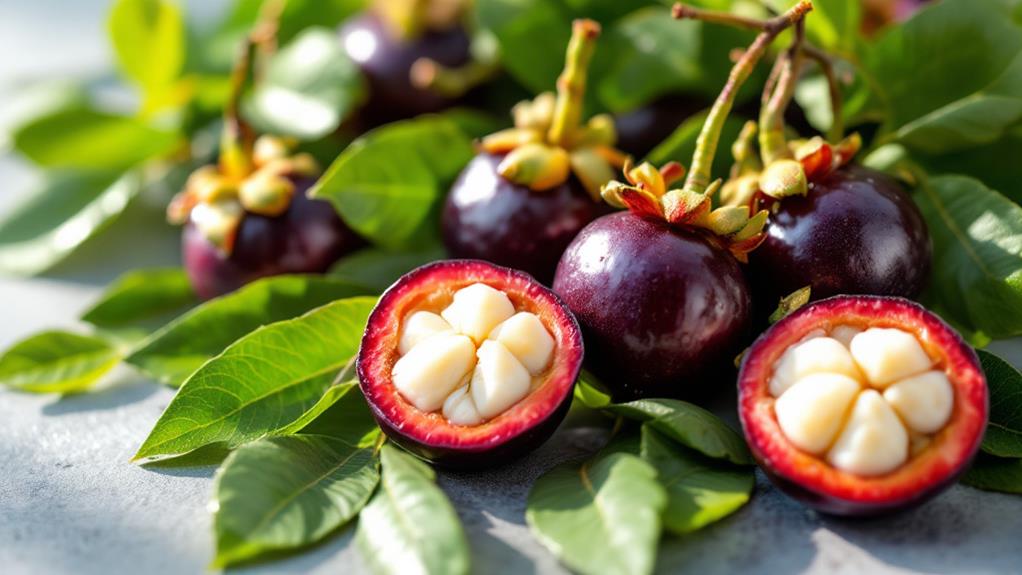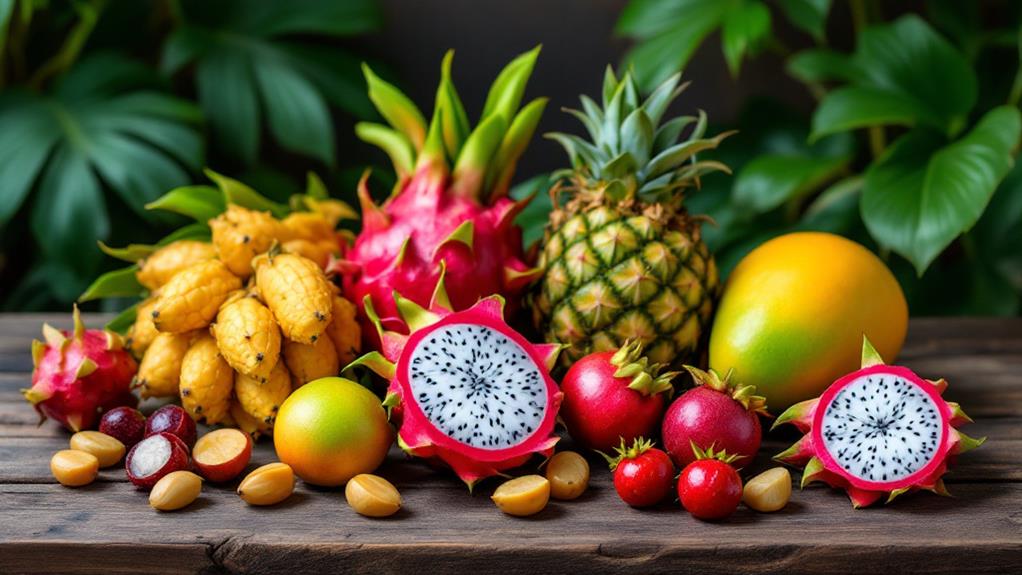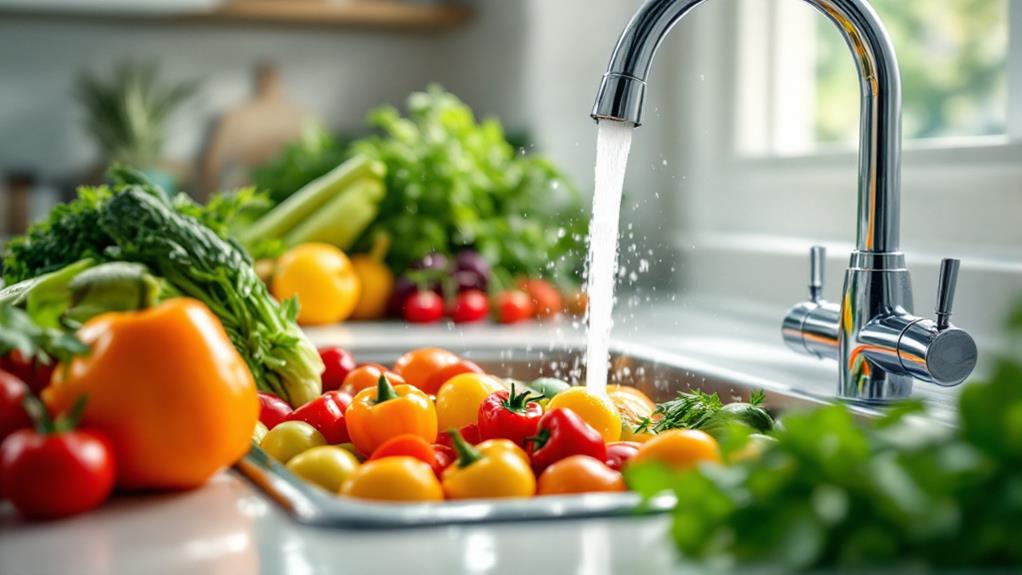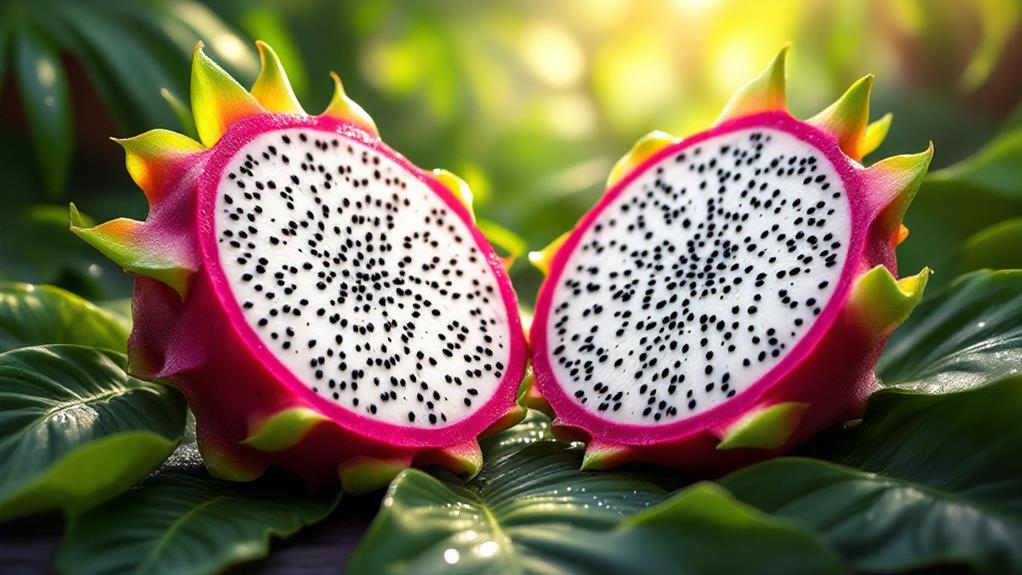Oceanic Fruits Guide: From Sea Grapes to Tropical Coconuts
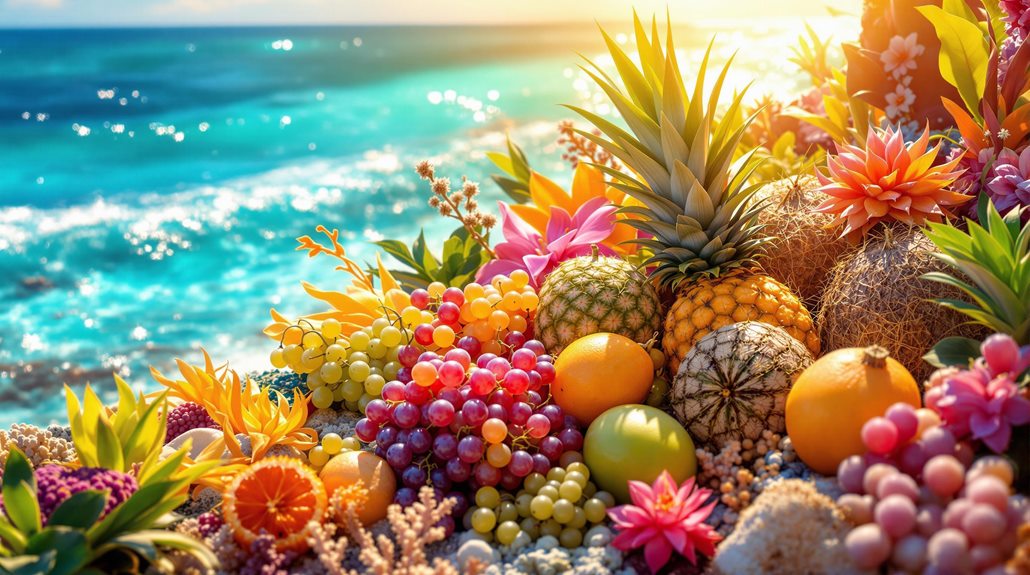
Investigate the fascinating world of oceanic fruits, where you'll uncover intriguing species like sea grapes and tropical coconuts. Sea grapes, thriving on coastal shores, offer a grape-like taste when ripe and are rich in antioxidants. Meanwhile, coconuts provide electrolytes and are perfect for hydration. These fruits aren't just nutritious; they're embedded in cultural traditions and enrich diverse culinary dishes. You can find sea grapes along the shores of South Florida, while coconuts grace the landscapes of the Caribbean and Southeast Asia. As you continue, you'll gain insights into the seasonality, cultural significance, and foraging tips of these oceanic gems.
Tropical Fruits Overview
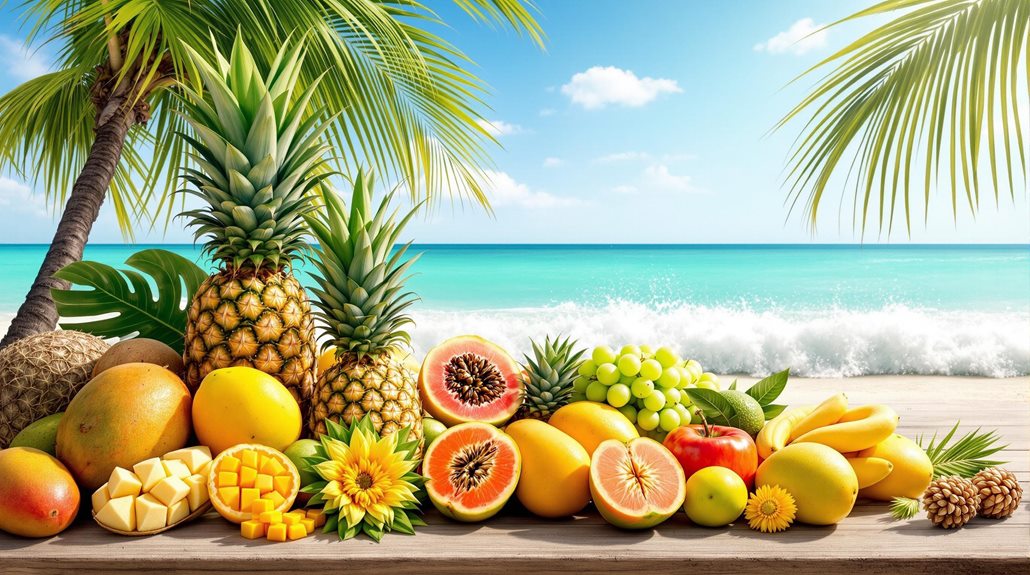
Picture a lively market stall brimming with tropical fruits, each one offering a taste of the equator's lush bounty. You're drawn to the colorful hues and intoxicating aromas of coconuts, pineapples, bananas, mangoes, and even the lesser-known sea grape, native to South Florida's coasts. These tropical fruits thrive in warm, humid climates, enjoying the ample rainfall found between the Tropic of Cancer and the Tropic of Capricorn.
Imagine biting into a juicy mango, the national fruit of both India and the Philippines, with its sweet, complex flavor that hints at coconut and pineapple. Over 100 varieties of mangoes enrich cuisines worldwide, each with a unique taste. Meanwhile, the durian and mangosteen stand out for their distinct characteristics—durian's strong odor and mangosteen's sweet, tangy flavor captivate adventurous palates.
Comprehending the seasonality of these fruits is essential. Mangoes are typically in season from April to November, while pineapples are best in August. This timing guarantees peak freshness and flavor, crucial for appreciating the full taste of tropical fruits. Next time you investigate these exotic options, remember the equatorial roots that give them life.
Unique Oceanic Varieties
As you explore the world of tropical fruits, don't overlook the unique oceanic varieties that flourish along coastal regions. Among these is the intriguing sea grape, native to tropical coastal areas. You'll find its clusters of purple fruit scattered along South Florida beaches. While ripe sea grapes offer a familiar grape-like taste, the unripe ones surprise with a briny flavor, reflecting their seaside origins. These fruits not only delight your taste buds but also highlight the diversity of native coastal flora.
Another fascinating specimen is the beach sheoak. While not a fruit-bearing tree, it's a fast-growing species that's found near the sea. However, it's considered invasive and less favorable for coastal landscaping, impacting native ecosystems.
Caution is required when you encounter the manchineel tree. Known for its highly toxic fruit, this tree can cause severe skin irritation, especially during rain when toxins can drip from its branches.
Lastly, there's the baycedar, a plant that thrives in salty, drought-prone environments. It stabilizes sandy soils, supports local wildlife, and its flowers are a magnet for pollinators. These unique oceanic varieties showcase the incredible adaptability and diversity found in coastal habitats.
Sea Grapes: A Closer Look
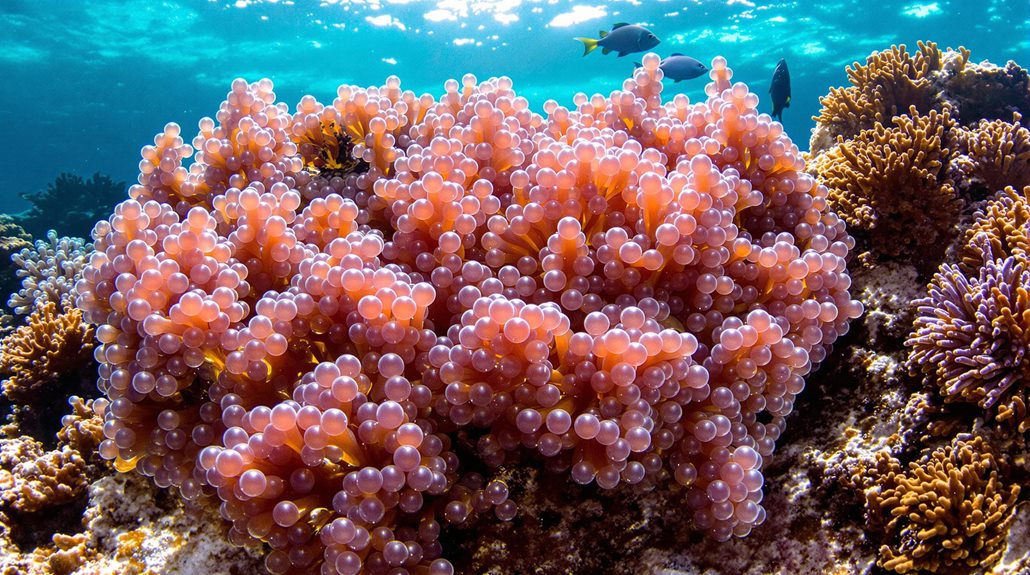
In the lively tapestry of coastal ecosystems, sea grapes (Coccoloba uvifera) stand out for their unique contributions and intriguing characteristics. Native to tropical coastal regions, these trees can grow up to 8-10 meters tall, producing clusters of purple fruits that resemble traditional grapes. If you're strolling along the sandy beaches of South Florida, you might spot these trees, with their ripe fruit attracting both wildlife and curious tourists.
Ripe sea grapes are sweet, offering a taste akin to the grapes you know, while the unripe ones possess a salty, briny flavor that's reminiscent of the sea itself. Sea grape trees don't just provide tasty fruit; they're fundamental to the environment. Their extensive root systems play an important role in preventing coastal erosion and stabilizing sandy areas, making them crucial for maintaining healthy coastlines.
Beyond their ecological importance, the leaves of sea grape trees have found a place in traditional medicine, valued for their anti-inflammatory properties. Their distinct shape and texture also make them popular in local crafts and art. In South Florida, visitors often mail stamped leaves as unique souvenirs, capturing a piece of coastal charm.
Nutritional Benefits
Sea grapes aren't just a coastal delight; they're packed with nutritional benefits that make them a worthy improvement to your diet. These tiny, pearl-like fruits are rich in antioxidants, which are vital in combating oxidative stress. By including sea grapes in your meals, you're actively supporting your general health and well-being. Antioxidants in sea grapes help neutralize harmful free radicals, reducing the risk of chronic diseases and promoting a healthier aging process.
Besides antioxidants, sea grapes offer dietary fiber, fundamental for maintaining digestive health and regularity. Incorporating dietary fiber into your diet aids in digestion and can help prevent constipation. This makes sea grapes an excellent choice for those looking to improve their gut health naturally.
On the tropical end, coconuts bring their own set of nutritional perks. They provide medium-chain triglycerides (MCTs), known for aiding in weight management and increasing energy. Plus, coconuts are a great source of electrolytes like potassium and sodium, which help maintain hydration and support muscle function. With both sea grapes and coconuts, you're adding a powerhouse of nutrients to your diet, improving both your health and culinary experience.
Regional Cultivation Areas
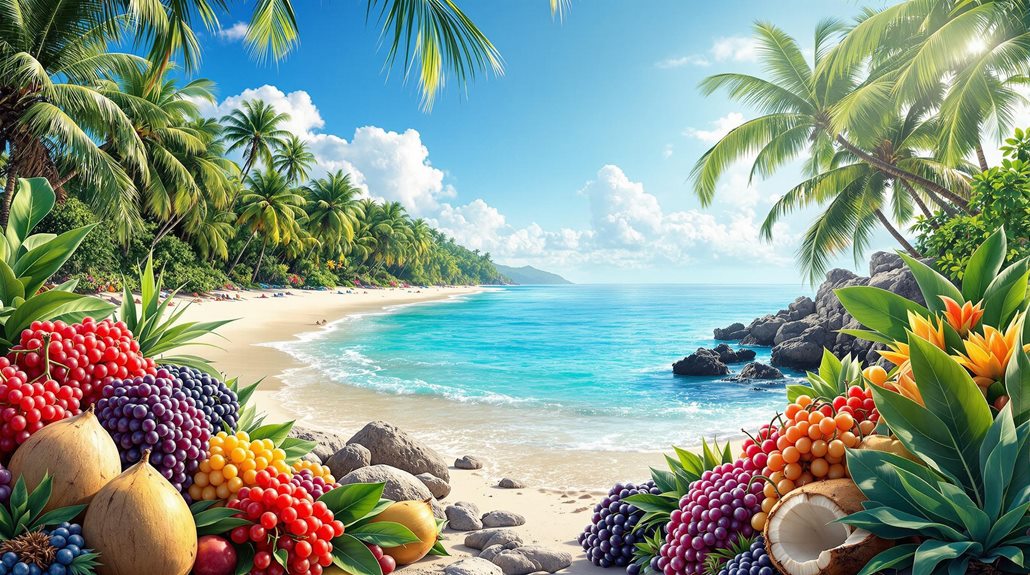
Having investigated the nutritional benefits of oceanic fruits, let's now consider where these nutritious delights are grown. Sea grapes, with their distinctive coastal appeal, thrive along the warm shores of South Florida and the Virgin Islands. You'll often find them dotting the picturesque beach landscapes of the Caribbean. Their resilience to salty air and sandy soils makes them perfect for these regions.
Now, if you're looking at tropical fruits like coconuts, they're cultivated extensively in balmy climates. The Caribbean is a prominent area where coconuts prosper, thanks to its warm, humid atmosphere. Hawaii and Southeast Asia also boast ideal conditions for coconut growth, ensuring a steady supply of this versatile fruit.
In the Dominican Republic, a diverse array of tropical fruits await. Mangoes, pineapples, and bananas are available year-round, thanks to the country's favorable weather conditions. Meanwhile, over in Florida, the subtropical climate supports the growth of avocados and starfruits, especially during the warmer months.
For more exotic tropical fruits like rambutan and mangosteen, Southeast Asia is your go-to region. The climate and soil there provide just the right environment for these unique fruits to flourish.
Culinary Uses and Recipes
Some might be surprised by the diverse culinary uses of oceanic fruits, immersing simple dishes into memorable delights. Sea grapes, with their unique briny flavor, can enhance your seafood salads or be transformed into delightful jams. Imagine tossing them into a fresh shrimp salad, where their salty tang perfectly complements the sweetness of the seafood.
Coconuts are a game-changer in the kitchen. You can use the meat to craft indulgent desserts like coconut macaroons or creamy curries. Coconut water serves as a revitalizing drink, hydrating you on a hot day or after a workout. Don't forget the oil, which is fantastic for frying or adding a tropical twist to your favorite baked goods.
Then there's passion fruit, a powerhouse of sweet and tangy flavors. It's perfect for crafting zesty cocktails, like a passion fruit mojito, or drizzling over a cheesecake for an exotic flair. You can even use it in savory sauces that pair beautifully with grilled fish or chicken, adding an unexpected burst of flavor. These oceanic fruits not only enrich your meals but also open a world of culinary creativity.
Cultural Significance
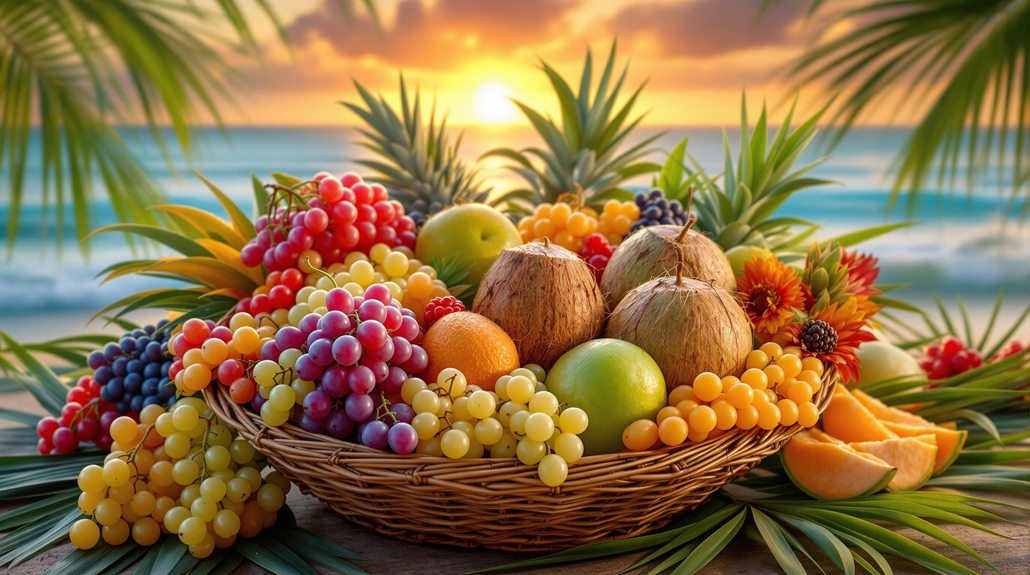
In many coastal and tropical cultures, oceanic fruits aren't just food; they're woven into the very fabric of tradition and identity. Take the sea grape, for instance. In the Virgin Islands, this humble fruit holds deep cultural significance. It's not just a staple in local folklore but also a symbol of resilience for coastal communities. You might find sea grapes featured in festivals and stories, celebrating their adaptability and strength.
In the Caribbean, sea grapes aren't just celebrated for their mythological ties. They're a culinary gem, transforming into jams, jellies, and beverages that reflect the region's rich heritage. When you savor a sea grape product, you're tasting centuries of tradition.
Beyond the Caribbean, other fruits like mangoes, guavas, and lychees also hold cultural importance. In India, the mango's role in religious ceremonies and festivals showcases its spiritual significance. Guavas are key in traditional medicine and culinary practices in tropical areas, bridging health and culture. Meanwhile, in Chinese culture, lychees symbolize love and romance, making them a staple in wedding traditions. These fruits, much like sea grapes, tell stories of cultural richness and identity across the globe.
Conservation and Sustainability
Amidst the pressing challenges of coastal development and climate change, the conservation and sustainability of sea grape trees have become fundamental. These trees are not just beautiful fixtures of coastal ecosystems; they're significant for preventing erosion and supporting wildlife. You must realize the importance of sustainable harvesting practices, which guarantee these plants continue to thrive without disrupting ecological balance.
By engaging in community conservation efforts, you can help protect and restore sea grape habitats. Local involvement is vital in these initiatives, as it promotes a sense of stewardship and responsibility. Education programs can play an important role by highlighting the ecological value of sea grape trees, encouraging you and others to participate actively.
Here's a snapshot of the challenges and solutions:
| Challenge | Solution |
|---|---|
| Coastal development | Implementing protected areas |
| Climate change effects | Promoting native flora restoration |
| Overharvesting | Educating on sustainable harvesting |
| Loss of biodiversity | Encouraging community conservation efforts |
Foraging Tips and Tricks
Foraging for oceanic fruits can be a rewarding and adventurous experience, revealing nature's hidden gems right in your neighborhood. Start by exploring local areas where tropical fruits like mangoes, starfruits, and avocados abound. Remember, it's essential to seek permission before foraging on private property. In Florida, ripe mulberries are a favorite among foragers, but watch out—they can stain your mouth! When searching for sea grapes, wait until they're fully ripe to enjoy their sweet taste, as unripe ones have a briny flavor.
Timing is everything. Spring is the best season to forage seasonal fruits like surinam cherries. Their peak sweetness and availability make them a delightful find. As for coconuts, they might require some tools and know-how to safely harvest, so familiarize yourself with the right techniques.
Enhance your foraging adventure by walking through local neighborhoods. You might uncover hidden fruit trees and plants that thrive in your area, adding an element of surprise to your quest. Always be mindful of the environment and verify that your foraging practices are sustainable, leaving enough fruit and foliage for nature and others to enjoy.

